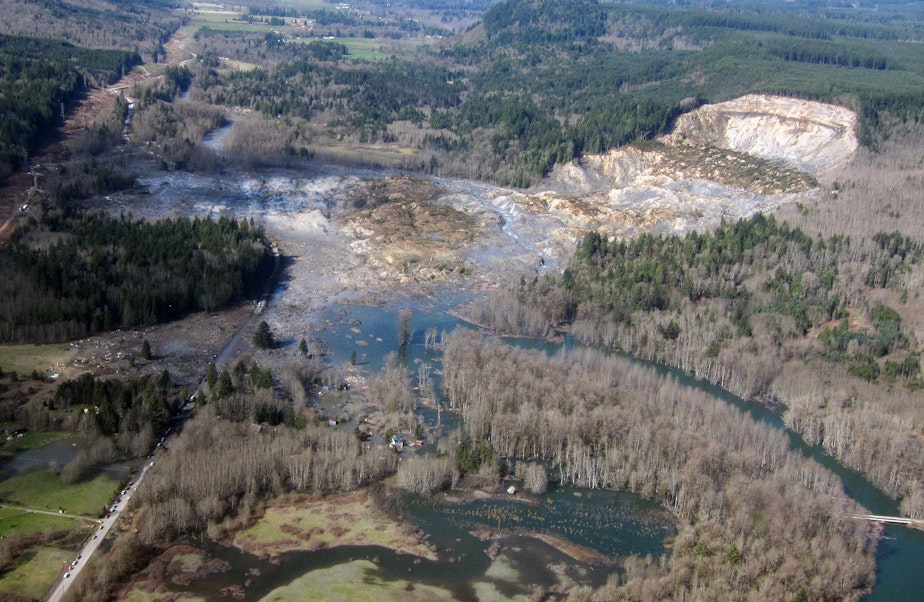Get on up: In a landslide, it might save your life

Imagine, after weeks of heavy rain this winter, a wave of mud and debris barrels into your home. What do you do?
Heading upstairs or even climbing on a countertop might save your life in a major landslide.
So could opening a door or window on the downhill side of your home to let mud out instead of piling up inside.
Such simple actions are key to whether a landslide claims lives or merely does property damage, according to a study of landslide disasters around the world from geotechnical engineers at the University of Washington.
“Overall, that’s a message of hope,” said lead author William Pollock.
The University of Washington lecturer said education on such techniques, targeted at people living in landslide zones, could save lives more cheaply than engineers’ efforts to hold landslides back or regulators’ efforts to keep people from building or living near them.
Sponsored
Worldwide, landslides kill thousands each year, including 25 to 50 people in a typical year in the United States.
Washington is one of the most landslide-prone states in this country.
The rainy season is also slide season in the Northwest.
When a wall of mud and trees plowed through the town of Oso on March 22, 2014, 43 people died, at least 10 were injured and 49 buildings were destroyed. In the first three weeks of that month, about 30 inches of rain, five times the monthly average, had fallen in the area.
Oso survivor Bobbi Aylesworth said the fact she and her husband were upstairs, she in a bathroom and he in bed, when the wall of mud hit made all the difference.
Sponsored
“Being upstairs, I think that gave us a chance,” Aylesworth told the Daily Herald of Everett shortly after she and her husband were rescued from the rubble of their home.
Based on studies and news reports of dozens of landslides hitting occupied buildings, the researchers found that a person upstairs is up to 12 times more likely to survive a landslide than someone on the ground floor.
Other potential life-saving strategies identified in the study include:
- Learn the specific landslide hazards where you live and which direction they move.
- Move bedrooms upstairs or to the downhill side of the building.
- During a landslide, relocate to an interior closet or bathroom, which are less likely to collapse than larger spaces. In 2005, a nurse in La Conchita, California, survived her home being buried in mud 30 feet deep by taking refuge in a closet. Rescuers pulled her out 4.5 hours later.
- If trapped in landslide debris, keep moving and making noise to alert rescuers.
Research on landslides has usually focused on geology, not human behavior: identifying where landslides are likely to occur and what triggers hillsides to succumb to gravity.
Sponsored
University of Washington geomorphologist David Montgomery, who was not involved in the study, praised its novel approach.
“They're really prioritizing the human dimension to this,” he said.
The study warns that fatalities are not the whole story: Survivors and even neighbors of landslides usually suffer post-traumatic stress disorder and other long-lasting repercussions.
“You can see that even now in the Oso area,” attorney Tim Trohimovich with the land-use advocacy group Futurewise said. “Some of these psychological impacts are still affecting people in the community.”
The new study did not address how public policies can save lives.
Sponsored
Since the Oso mudslide, Snohomish County and some other counties in Washington have tightened their rules on building homes inside landslide zones.
Others haven’t.
Trohimovich said Futurewise is currently negotiating with Spokane County to get it to better identify landslide hazards and protect people from them.
The Washington Department of Natural Resources has produced detailed maps of landslide zones, using LiDAR imagery that penetrates vegetation to reveal the landforms below, for King, Pierce and Whatcom counties.
The U.S. House of Representatives passed a landslide-preparedness bill in June that would make similar information available nationwide.
Sponsored
Those initiatives have focused on slide-prone slopes themselves, not the areas below, like Oso’s Steelhead Haven neighborhood, that the liquefied earth then slams into.
“Some of the people who lived at Oso had no idea they lived in a geologically hazardous area,” Trohimovich said. “That happens elsewhere.”
“What we have not really stepped up to, in this state or indeed in most other areas, is to actually map the potential runout paths,” Montgomery said, “the places that are not actually involved in the initial failure, but they could be overwhelmed by sediment.”
One other message of hope from the study in the journal GeoHealth: Neighborliness saves lives.
“Of victims who were rescued, 77% were first located by neighbors and 11% by emergency response,” the study found.




